2006 SUBARU OUTBACK warning light
[x] Cancel search: warning lightPage 266 of 425
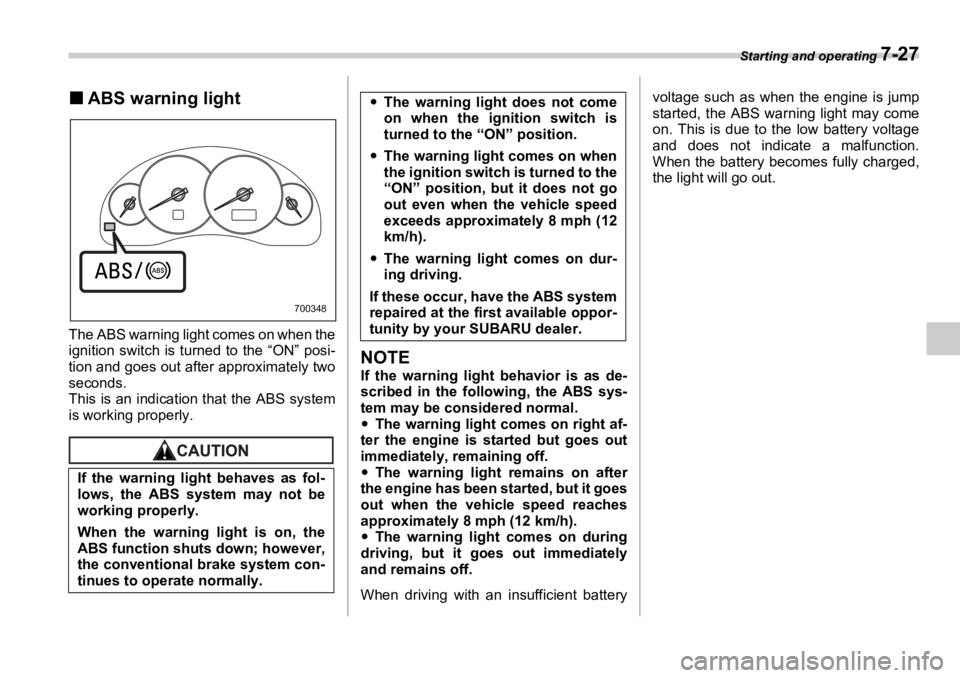
Starting and operating
7-27�„ ABS warning light
The ABS warning light comes on when the
ignition switch is turned to the “ON” posi-
tion and goes out after approximately two
seconds.
This is an indication that the ABS system
is working properly.
NOTE If the warning light behavior is as de-
scribed in the following, the ABS sys-
tem may be considered normal.
�y The warning light comes on right af-
ter the engine is started but goes out
immediately, remaining off.
�y The warning light remains on after
the engine has been started, but it goes
out when the vehicle speed reaches
approximately 8 mph (12 km/h).
�y The warning light comes on during
driving, but it goes out immediately
and remains off.
When driving with an insufficient battery voltage such as when the engine is jump
started, the ABS warn ing light may come
on. This is due to the low battery voltage
and does not indicate a malfunction.
When the battery becomes fully charged,
the light will go out.
If the warning light behaves as fol-
lows, the ABS system may not be
working properly.
When the warning light is on, the
ABS function shuts down; however,
the conventional brake system con-
tinues to operate normally. 700348�y The warning light does not come
on when the ignition switch is
turned to the “ON” position.
�y The warning light comes on when
the ignition switch is turned to the
“ON” position, but it does not go
out even when the vehicle speed
exceeds approximately 8 mph (12
km/h).
�y The warning light comes on dur-
ing driving.
If these occur, have the ABS system
repaired at the first available oppor-
tunity by your SUBARU dealer.
Page 267 of 425
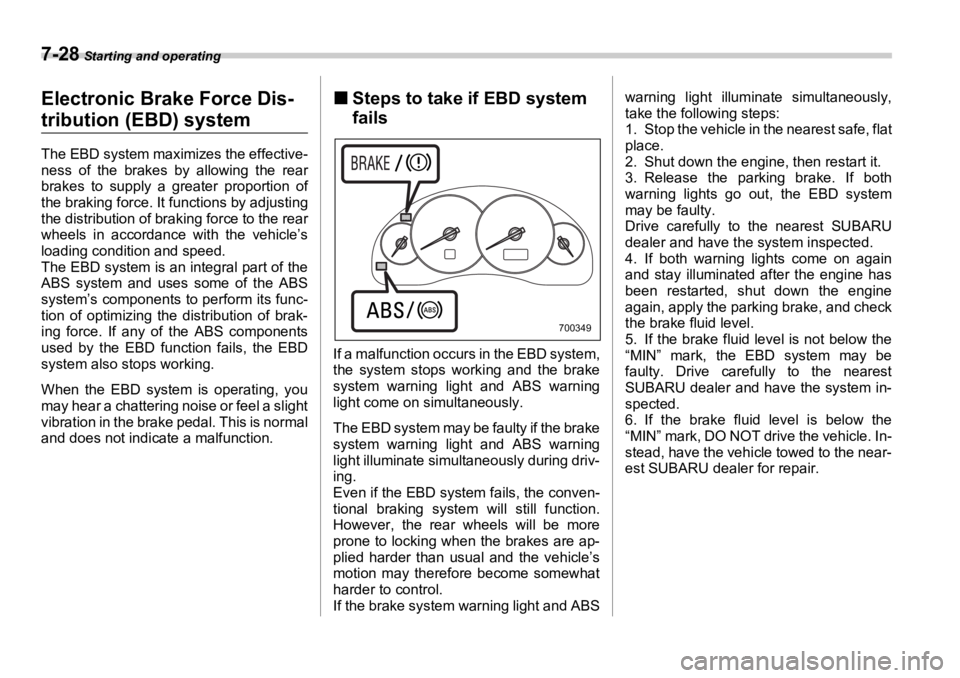
7-28 Starting and operating
Electronic Br ake Force Dis-
tribution (EBD) system The EBD system maximizes the effective-
ness of the brakes by allowing the rear
brakes to supply a greater proportion of
the braking force. It functions by adjusting
the distribution of brak ing force to the rear
wheels in accordance with the vehicle’s
loading condition and speed.
The EBD system is an integral part of the
ABS system and uses some of the ABS
system’s components to perform its func-
tion of optimizing the distribution of brak-
ing force. If any of the ABS components
used by the EBD function fails, the EBD
system also stops working.
When the EBD system is operating, you
may hear a chattering noise or feel a slight
vibration in the brake pedal. This is normal
and does not indicate a malfunction. �„ Steps to take if EBD system
fails
If a malfunction occu rs in the EBD system,
the system stops working and the brake
system warning light and ABS warning
light come on simultaneously.
The EBD system may be faulty if the brake
system warning light and ABS warning
light illuminate simultaneously during driv-
ing.
Even if the EBD system fails, the conven-
tional braking system will still function.
However, the rear wheels will be more
prone to locking when the brakes are ap-
plied harder than usual and the vehicle’s
motion may therefore become somewhat
harder to control.
If the brake system warning light and ABS warning light illuminate simultaneously,
take the following steps:
1. Stop the vehicle in the nearest safe, flat
place.
2. Shut down the engine, then restart it.
3. Release the parking brake. If both
warning lights go out, the EBD system
may be faulty.
Drive carefully to the nearest SUBARU
dealer and have the system inspected.
4. If both warning lights come on again
and stay illuminated after the engine has
been restarted, shut down the engine
again, apply the parking brake, and check
the brake fluid level.
5. If the brake fluid level is not below the
“MIN” mark, the EBD system may be
faulty. Drive carefully to the nearest
SUBARU dealer and have the system in-
spected.
6. If the brake fluid level is below the
“MIN” mark, DO NOT drive the vehicle. In-
stead, have the vehicle towed to the near-
est SUBARU dealer for repair. 700349
Page 268 of 425
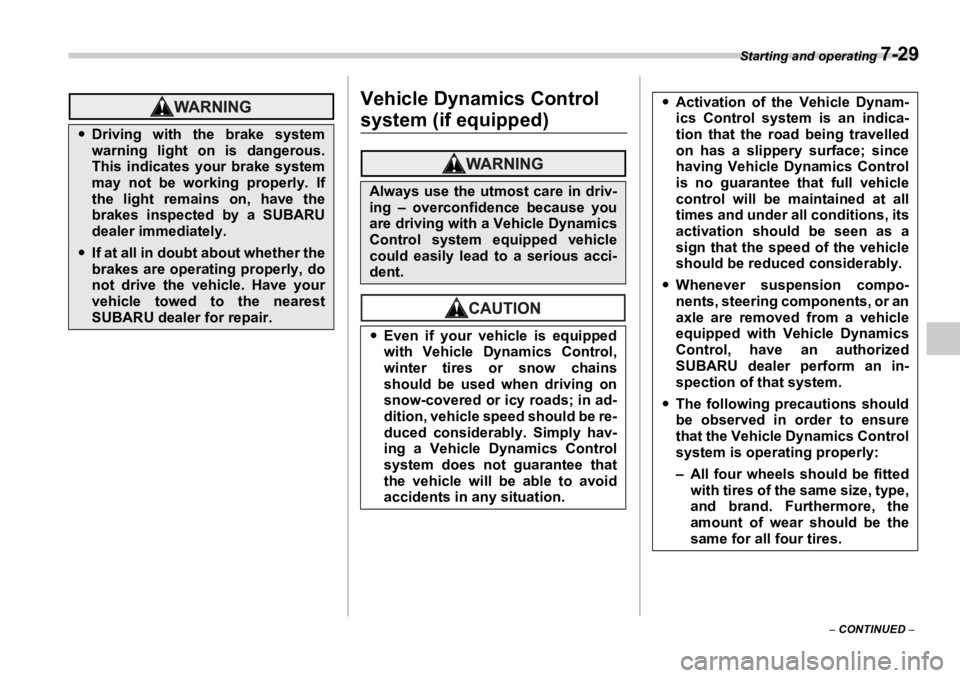
Starting and operating
7-29
– CONTINUED –Vehicle Dynamics Control
system (if equipped)�y Driving with the brake system
warning light on is dangerous.
This indicates your brake system
may not be working properly. If
the light remains on, have the
brakes inspected by a SUBARU
dealer immediately.
�y If at all in doubt about whether the
brakes are operating properly, do
not drive the vehicle. Have your
vehicle towed to the nearest
SUBARU dealer for repair. Always use the utmost care in driv-
ing – overconfidence because you
are driving with a Vehicle Dynamics
Control system equipped vehicle
could easily lead to a serious acci-
dent.
�y Even if your vehicle is equipped
with Vehicle Dynamics Control,
winter tires or snow chains
should be used when driving on
snow-covered or icy roads; in ad-
dition, vehicle speed should be re-
duced considerably. Simply hav-
ing a Vehicle Dynamics Control
system does not guarantee that
the vehicle will be able to avoid
accidents in any situation. �y Activation of the Vehicle Dynam-
ics Control system is an indica-
tion that the ro ad being travelled
on has a slippery surface; since
having Vehicle Dynamics Control
is no guarantee that full vehicle
control will be maintained at all
times and under all conditions, its
activation should be seen as a
sign that the speed of the vehicle
should be reduced considerably.
�y Whenever suspension compo-
nents, steering components, or an
axle are removed from a vehicle
equipped with Vehicle Dynamics
Control, have an authorized
SUBARU dealer perform an in-
spection of that system.
�y The following precautions should
be observed in order to ensure
that the Vehicle Dynamics Control
system is operating properly:
– All four wheels should be fitted
with tires of the same size, type,
and brand. Furthermore, the
amount of wear should be the
same for all four tires.
Page 270 of 425

Starting and operating
7-31
– CONTINUED –erate correctly as intended.
�y Always turn off the engine before re-
placing a tire as failure to do so may
render the Vehicle Dynamics Control
system unable to operate correctly.
�„ Vehicle Dynamics Control
system monitor�T Vehicle Dynamics Control operation
indicator light
The indicator light turns on when the igni-
tion switch is turned to the ON position; it
turns off approximately two seconds later.
This indicator light flashes during activa-
tion of the skid suppression function and is
illuminated steadily during activation of
the traction cont rol function. The following two situations could indicate
a malfunction of the Vehicle Dynamics
Control system; if either should occur,
have an authorized SUBARU dealer carry
out an inspection of that system at the first
available opportunity.
�y The indicator light does not turn on
when the ignition switch is turned to the
ON position.
�y The indicator light does not turn off ap-
proximately two seconds after the ignition
switch has been turned to the ON position.
�T Vehicle Dynamics Control warning
light/Vehicle Dynamics Control OFF
indicator light
This single light has the function of indicat-
ing malfunctions in the Vehicle Dynamics
Control system and the function of indicat- ing that the Vehicle Dynamics Control sys-
tem is not operating. It comes on in the
event of a malfunction in the system and is
illuminated whenever the system is not
operating.
�V Vehicle Dynamics Control warning
The warning light comes on when the igni-
tion switch is turned to the “ON” position
and goes off several seconds after engine
startup. This lighting pattern indicates that
the Vehicle Dynamics Control system is
operating normally.
The following situations could indicate a
malfunction of the Vehicle Dynamics Con-
trol system; if any should occur, have an
authorized SUBARU dealer carry out an
inspection of the system at the first avail-
able opportunity.
�y The warning light does not turn on when
the ignition switch is turned to the ON po-
sition.
�y The warning light turns on while the ve-
hicle is being driven.
�y When a malfunction has occurred in the
Vehicle Dynamics Control electrical sys-
tem, only the warning light will turn on. In
such an event, the ABS will still be operat-
ing normally.
�y The warning light will also turn on when
a problem occurs with the ABS or Vehicle
Dynamics Control electronic control sys-700350
700351
Page 271 of 425
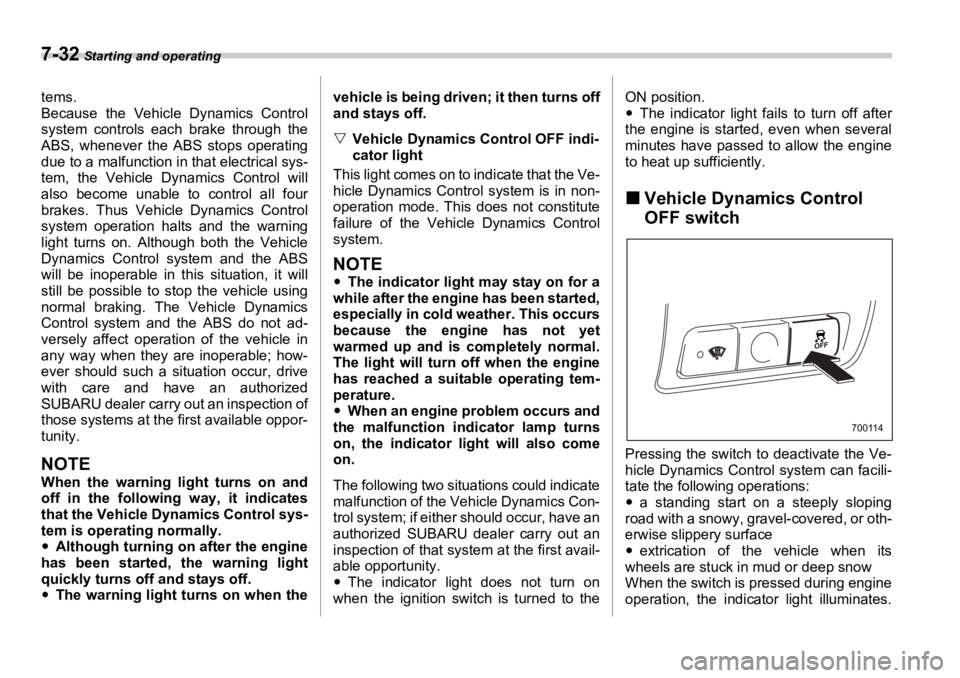
7-32 Starting and operating
tems.
Because the Vehicle Dynamics Control
system controls each brake through the
ABS, whenever the ABS stops operating
due to a malfunction in that electrical sys-
tem, the Vehicle Dynamics Control will
also become unable to control all four
brakes. Thus Vehicle Dynamics Control
system operation halt s and the warning
light turns on. Although both the Vehicle
Dynamics Control system and the ABS
will be inoperable in this situation, it will
still be possible to stop the vehicle using
normal braking. The Vehicle Dynamics
Control system and the ABS do not ad-
versely affect operation of the vehicle in
any way when they are inoperable; how-
ever should such a situation occur, drive
with care and have an authorized
SUBARU dealer carry out an inspection of
those systems at the first available oppor-
tunity.
NOTE When the warning light turns on and
off in the following way, it indicates
that the Vehicle Dynamics Control sys-
tem is operating normally.
�y Although turning on after the engine
has been started, the warning light
quickly turns off and stays off.
�y The warning light turns on when the vehicle is being driven; it then turns off
and stays off.
�V Vehicle Dynamics Control OFF indi-
cator light
This light comes on to indicate that the Ve-
hicle Dynamics Control system is in non-
operation mode. This does not constitute
failure of the Vehicle Dynamics Control
system.
NOTE �y The indicator light may stay on for a
while after the engine has been started,
especially in cold weather. This occurs
because the engine has not yet
warmed up and is completely normal.
The light will turn off when the engine
has reached a suitable operating tem-
perature.
�y When an engine problem occurs and
the malfunction indicator lamp turns
on, the indicator light will also come
on.
The following two situations could indicate
malfunction of the Vehicle Dynamics Con-
trol system; if either should occur, have an
authorized SUBARU dealer carry out an
inspection of that syst em at the first avail-
able opportunity.
�y The indicator light does not turn on
when the ignition switch is turned to the ON position.
�y The indicator light fail s to turn off after
the engine is started, even when several
minutes have passed to allow the engine
to heat up sufficiently.
�„ Vehicle Dynamics Control
OFF switch
Pressing the switch to deactivate the Ve-
hicle Dynamics Contro l system can facili-
tate the following operations:
�y a standing start on a steeply sloping
road with a snowy, grav el-covered, or oth-
erwise slippery surface
�y extrication of the vehicle when its
wheels are stuck in mud or deep snow
When the switch is pressed during engine
operation, the indicator light illuminates. 700114
Page 272 of 425
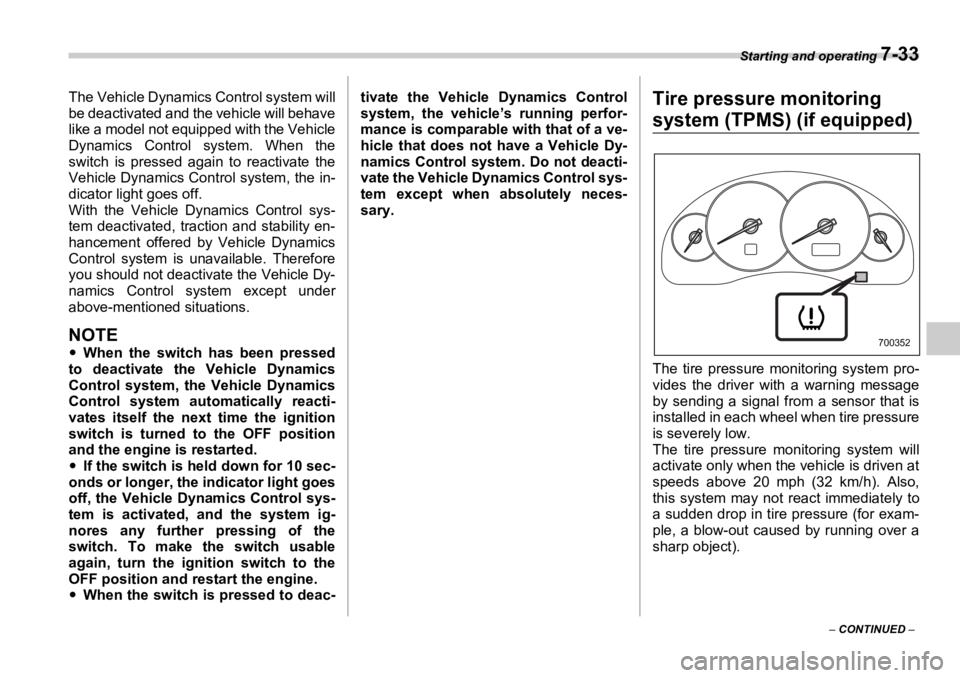
Starting and operating
7-33
– CONTINUED –The Vehicle Dynamics Control system will
be deactivated and the vehicle will behave
like a model not equipped with the Vehicle
Dynamics Control system. When the
switch is pressed again to reactivate the
Vehicle Dynamics Control system, the in-
dicator light goes off.
With the Vehicle Dynamics Control sys-
tem deactivated, traction and stability en-
hancement offered by Vehicle Dynamics
Control system is unavailable. Therefore
you should not deactivate the Vehicle Dy-
namics Control syst em except under
above-mentioned situations.
NOTE �y When the switch has been pressed
to deactivate the Vehicle Dynamics
Control system, the Vehicle Dynamics
Control system automatically reacti-
vates itself the next time the ignition
switch is turned to the OFF position
and the engine is restarted.
�y If the switch is held down for 10 sec-
onds or longer, the indicator light goes
off, the Vehicle Dynamics Control sys-
tem is activated, and the system ig-
nores any further pressing of the
switch. To make the switch usable
again, turn the igni tion switch to the
OFF position and restart the engine.
�y When the switch is pressed to deac- tivate the Vehicle Dynamics Control
system, the vehicle’s running perfor-
mance is comparable with that of a ve-
hicle that does not have a Vehicle Dy-
namics Control system. Do not deacti-
vate the Vehicle Dynamics Control sys-
tem except when absolutely neces-
sary.
Tire pressure monitoring
system (TPMS) (if equipped)
The tire pressure monitoring system pro-
vides the driver with a warning message
by sending a signal from a sensor that is
installed in each wheel when tire pressure
is severely low.
The tire pressure mo nitoring system will
activate only when the vehicle is driven at
speeds above 20 mph (32 km/h). Also,
this system may not react immediately to
a sudden drop in tire pressure (for exam-
ple, a blow-out caused by running over a
sharp object). 700352
Page 273 of 425

7-34 Starting and operating
If the low tire pressure warning light
comes on while driving, never brake
suddenly and keep driving straight
ahead while gradually reducing
speed. Then slowly pull off the road
to a safe place. Otherwise an acci-
dent involving serious vehicle dam-
age and serious personal injury
could occur.
Check the pressure for all four tires
and adjust the pressure to the COLD
tire pressure shown on the tire plac-
ard on the door pillar on the driver’s
side. Even when the vehicle is driven a
very short distance, the tires get
warm and their pressures increase
accordingly. Be sure to let the tires
cool thoroughly before adjusting
their pressures to the standard val-
ues shown on the tire placard. (Re-
fer to the “Tires and wheels” section
in chapter 11.) The tire pressure
monitoring system does not func-
tion when the vehicle is stationary.
After adjusting the tire pressures,
increase the vehicle speed to at
least 20 mph (32 km /h) to start the
TPMS re-checking of the tire infla-
tion pressures. If the tire pressures
are now above the severe low pres-
sure threshold, the low tire pressure
warning light should go off a few
minutes later. If this light still comes on while driv-
ing after adjusting the tire pressure,
a tire may have significant damage
and a fast leak that causes the tire to
lose air rapidly. If you have a flat tire,
replace it with a spare tire as soon
as possible. When a spare tire is
mounted or a wheel rim is replaced
without the original pressure sen-
sor/transmitter being transferred,
the low tire pressure warning light
will flash. This indicates the TPMS is
unable to monitor all four road
wheels. Contact your SUBARU deal-
er as soon as possible for tire and
sensor replacement and/or system
resetting.
Do not inject any tire liquid or aero-
sol tire sealant into the tires, as this
may cause a malfunction of the tire
pressure sensors. If the light flash-
es, promptly contact a SUBARU
dealer to have the system inspect-
ed.
Page 275 of 425
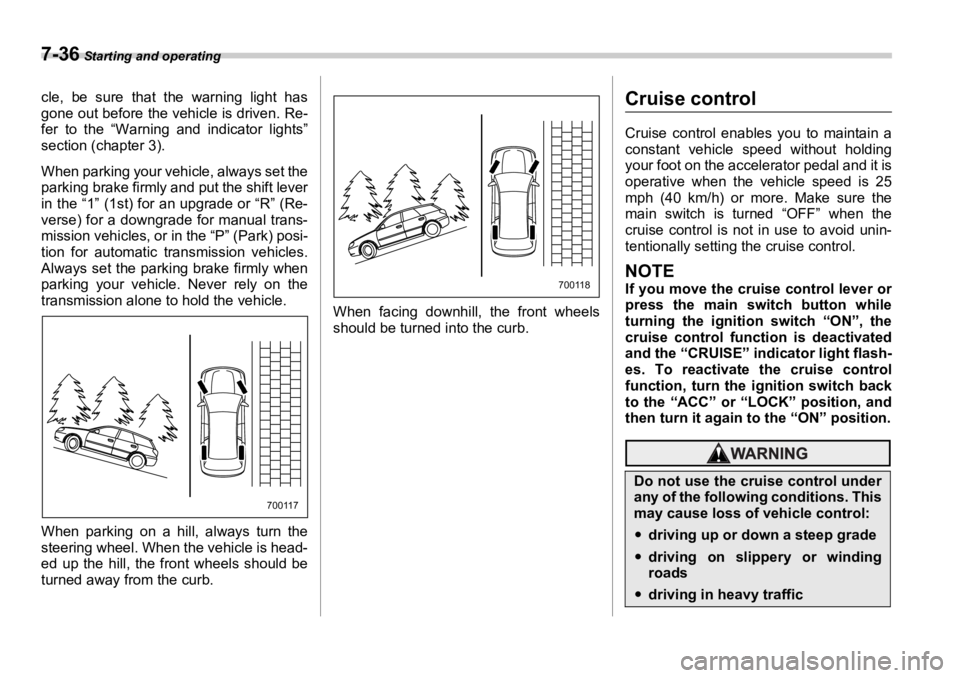
7-36 Starting and operating
cle, be sure that the warning light has
gone out before the vehicle is driven. Re-
fer to the “Warning and indicator lights”
section (chapter 3).
When parking your vehicle, always set the
parking brake firmly and put the shift lever
in the “1” (1st) for an upgrade or “R” (Re-
verse) for a downgrade for manual trans-
mission vehicles, or in the “P” (Park) posi-
tion for automatic transmission vehicles.
Always set the parking brake firmly when
parking your vehicle. Never rely on the
transmission alone to hold the vehicle.
When parking on a hill, always turn the
steering wheel. When the vehicle is head-
ed up the hill, the front wheels should be
turned away from the curb. When facing downhill, the front wheels
should be turned into the curb. Cruise control Cruise control enables you to maintain a
constant vehicle speed without holding
your foot on the accelerator pedal and it is
operative when the vehicle speed is 25
mph (40 km/h) or more. Make sure the
main switch is turned “OFF” when the
cruise control is not in use to avoid unin-
tentionally setting the cruise control.
NOTE If you move the cruise control lever or
press the main switch button while
turning the ignition switch “ON”, the
cruise control function is deactivated
and the “CRUISE” indicator light flash-
es. To reactivate the cruise control
function, turn the ignition switch back
to the “ACC” or “LOCK” position, and
then turn it again to the “ON” position.
700117 700118
Do not use the cruise control under
any of the following conditions. This
may cause loss of vehicle control:
�y driving up or down a steep grade
�y driving on slippery or winding
roads
�y driving in heavy traffic